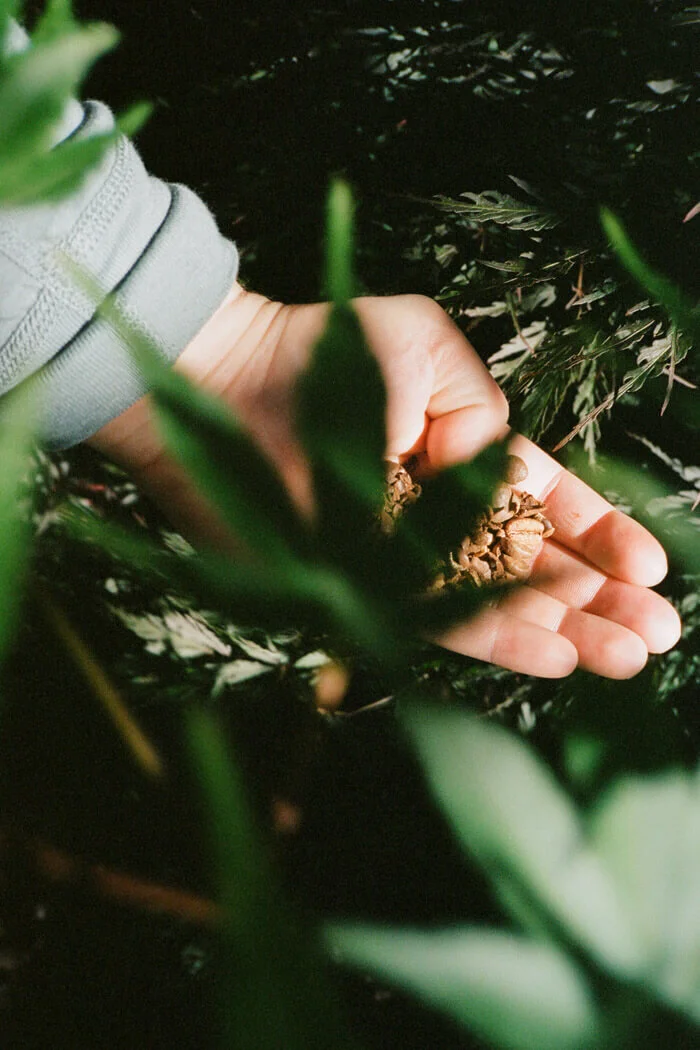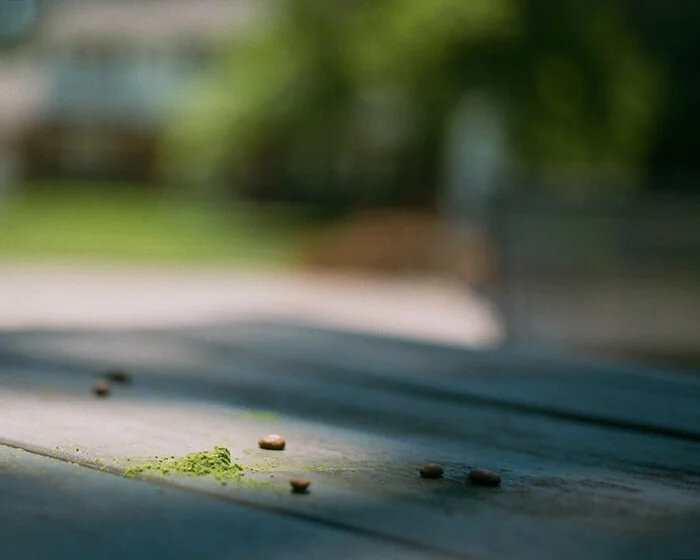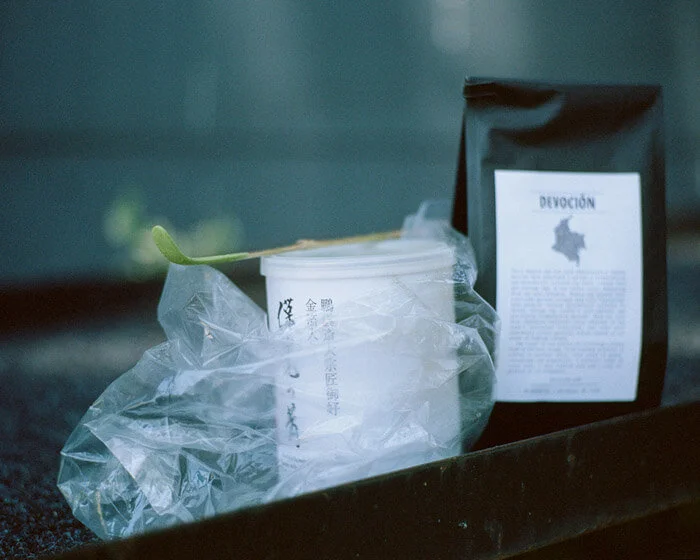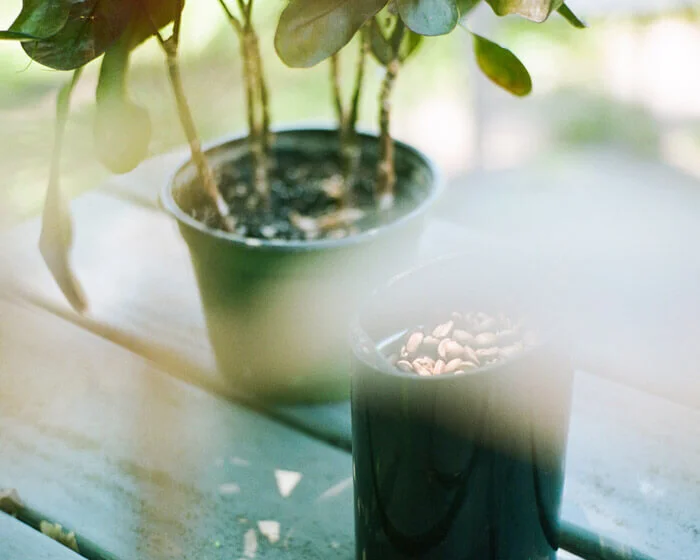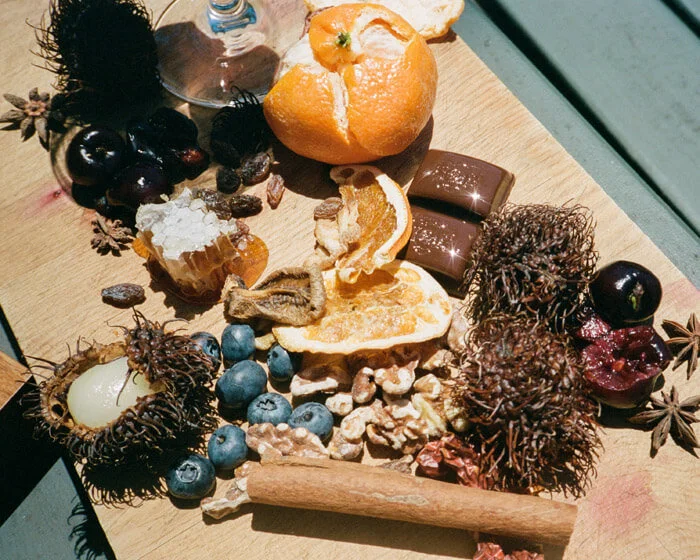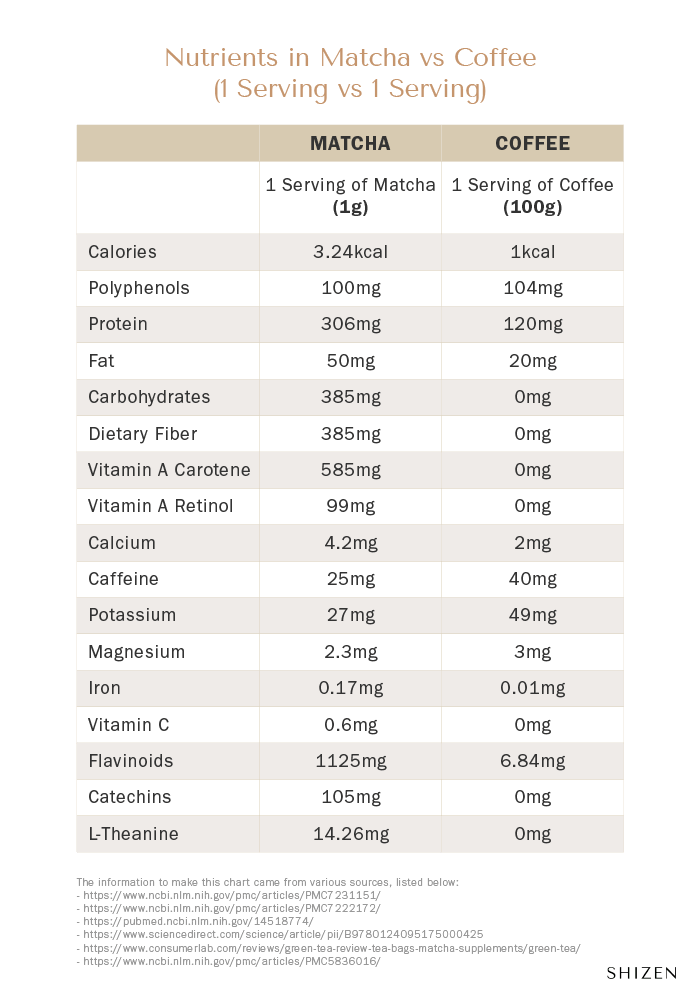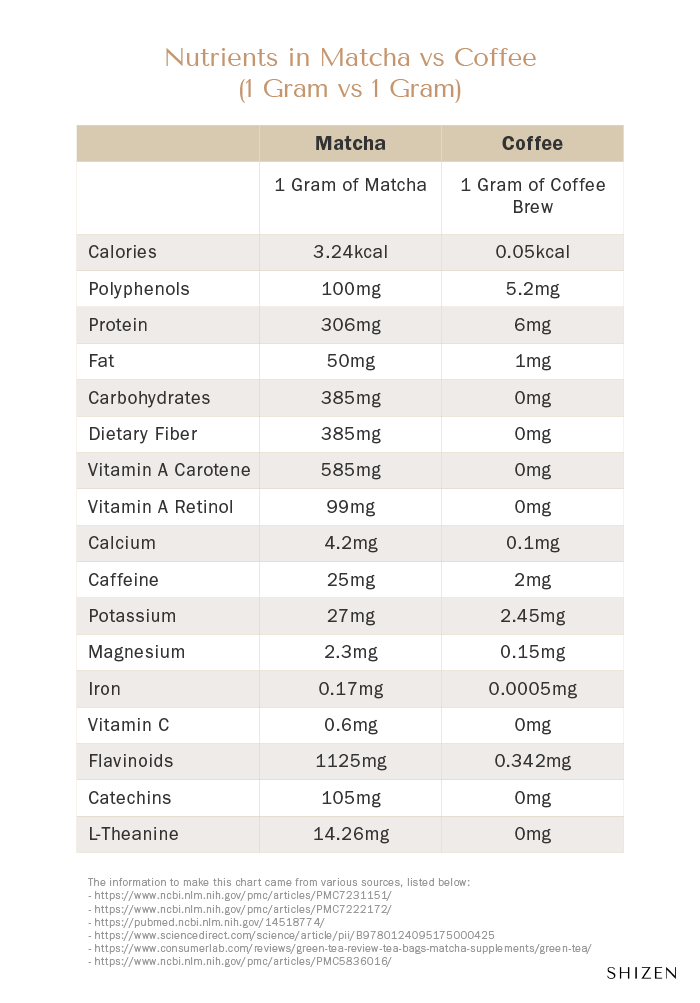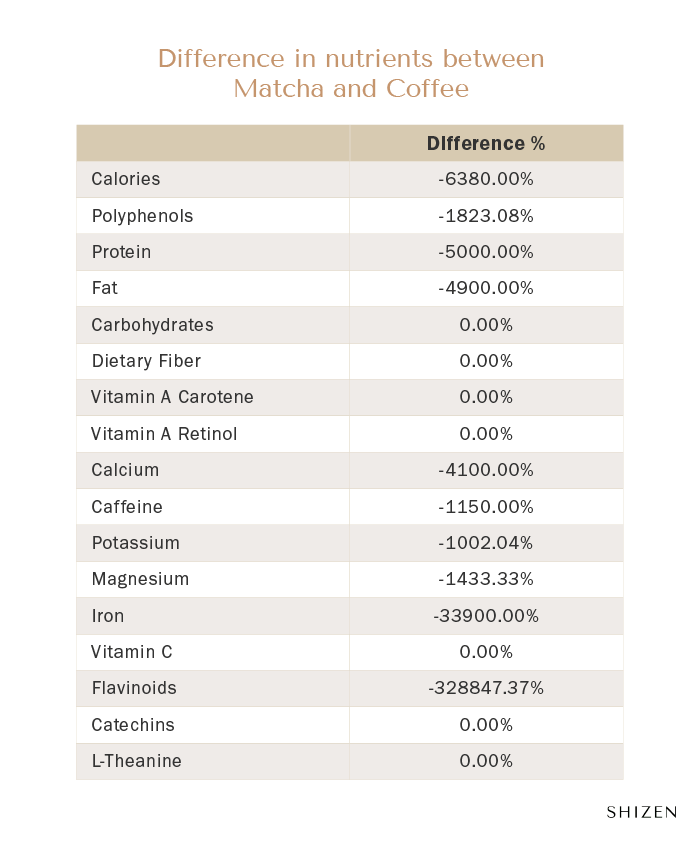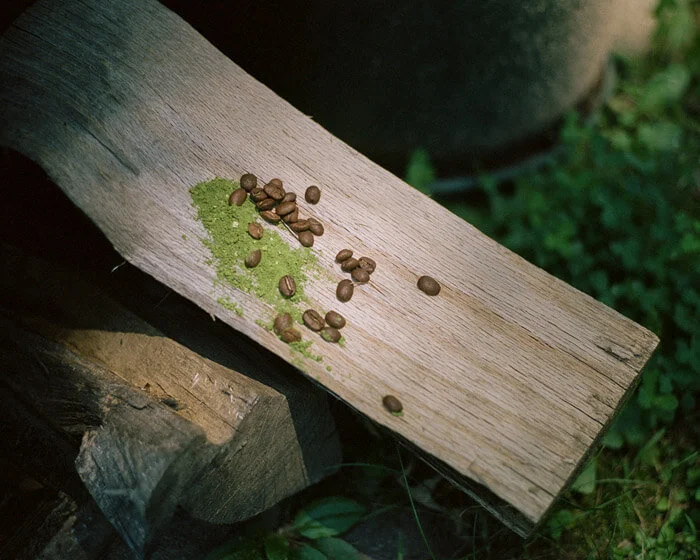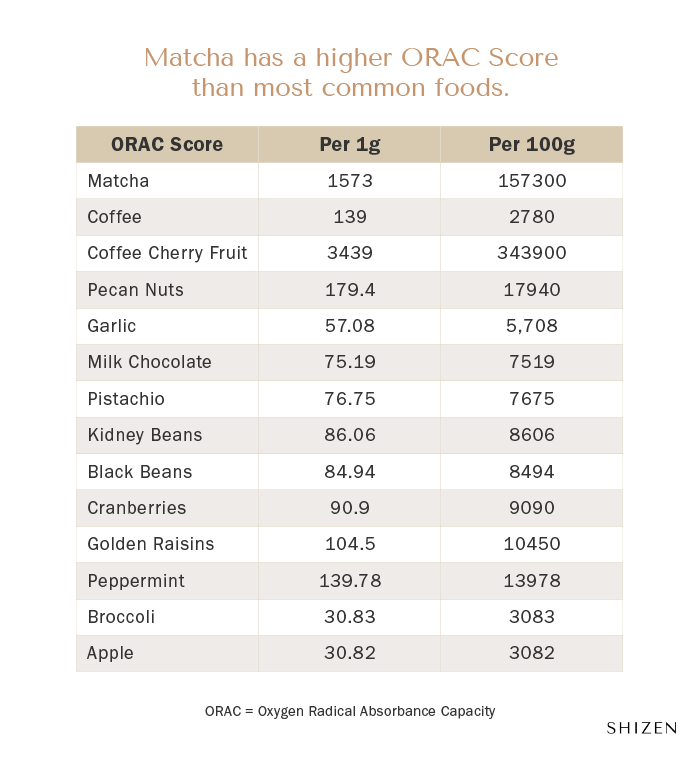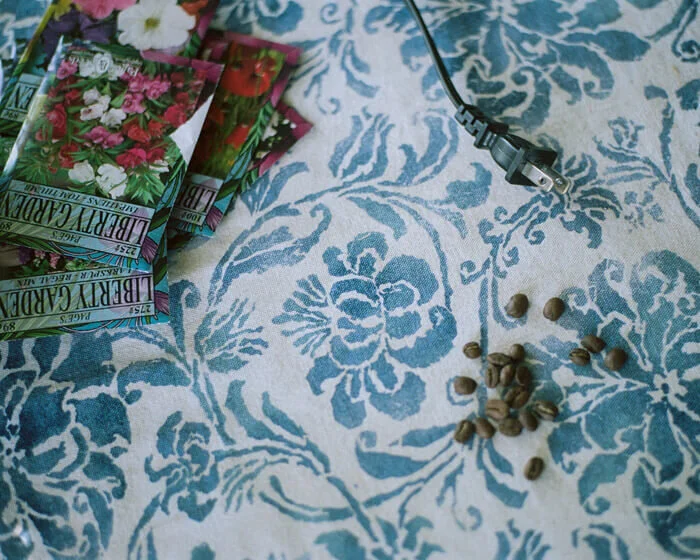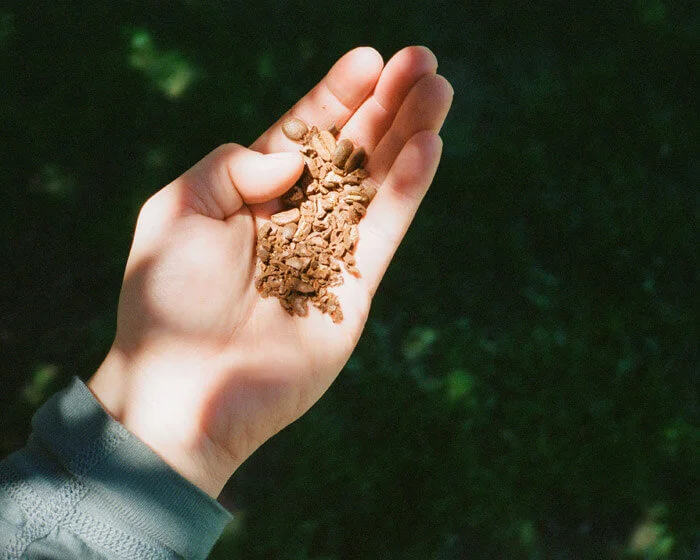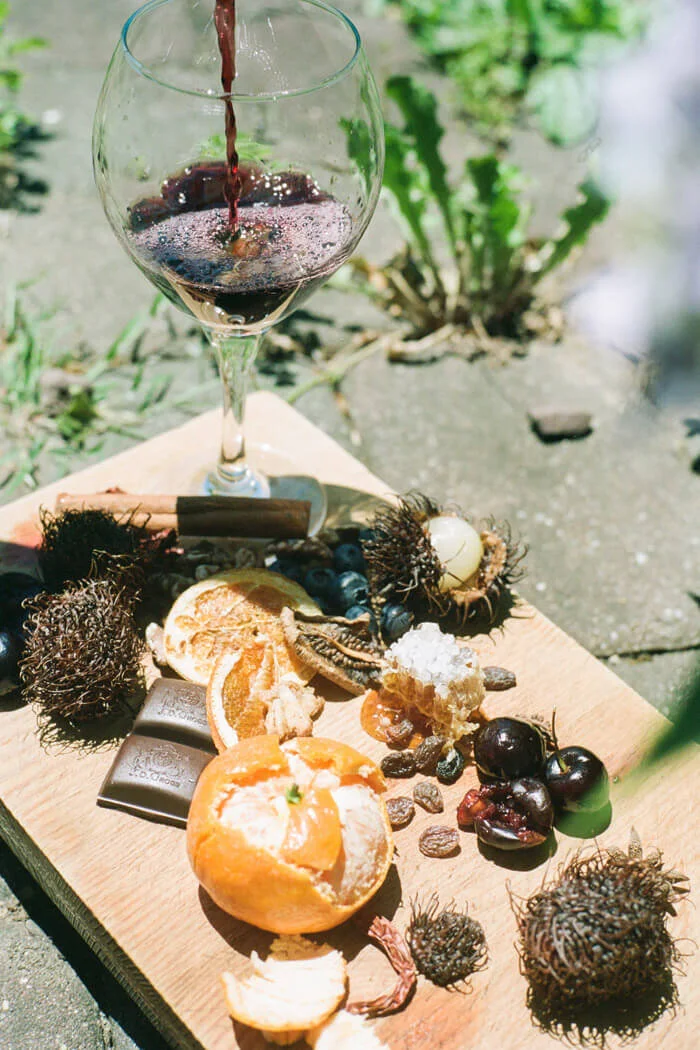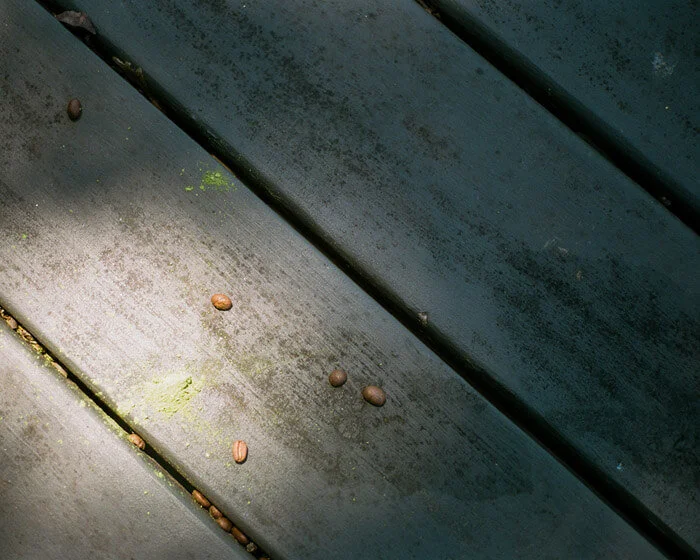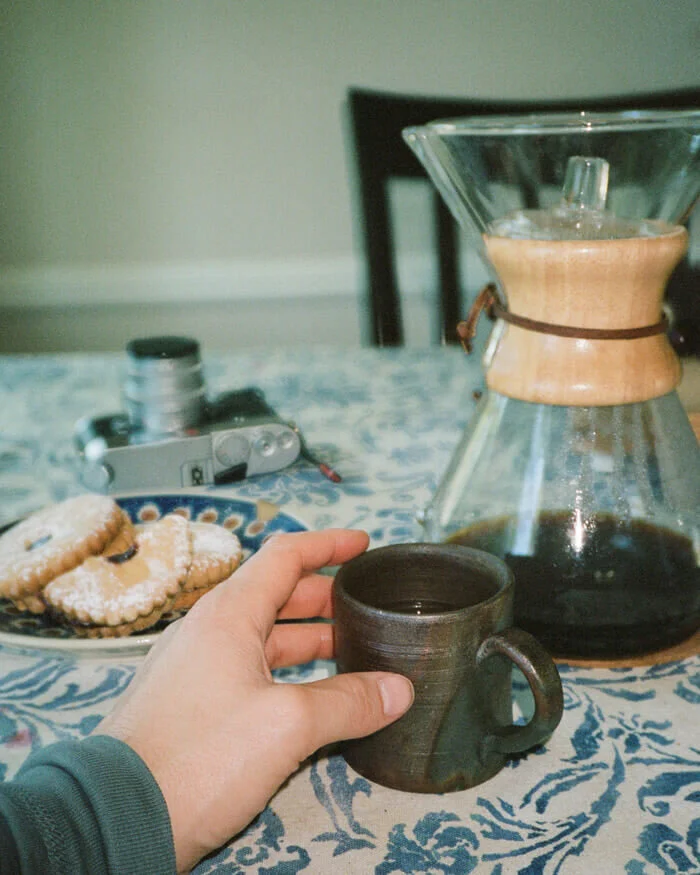Matcha vs Coffee: The Complete List of Differences
Matcha and Coffee are quite different from each other… and people often favor one over the other. I enjoy drinking both, but at the end of the day Matcha beats out coffee for several reasons.
Drinking Matcha feels a lot different than drinking coffee… But beyond the caffeine, what makes them different?
Let’s find out together in this article. We'll go over the complete list of 8 differences between coffee and Matcha…
From taste
To growing
To caffeine content
And everything in between
So grab some Matcha (and maybe even some coffee) and let's get started.
1 - What are the Main Differences Between Coffee and Tea?
Well, they are fundamentally totally different plants. This accounts for some significant differences in taste, aroma, health benefits, cultures surrounding them, etc.
So while it may seem a bit obvious, it's super important to realize and understand that these 2 beverages both come from plants. And the differences in growing location, processing, and making all change their flavors.
Let's take a quick look at some basics about the tea plant and the coffee plant so you can see what I’m talking about here.
The Tea Plant - Camellia Sinensis
The scientific name for the tea plant that Matcha is made from is Camellia Sinensis. It’s a flowering evergreen bush that sometimes grows into full-sized trees in some wild varietals.
Extra info: A varietal is just a different version of a plant. Think different grapes for different wines, or different kinds of tomatoes at the grocery store.
Different teas are made from different varietals and different processes. So – you can have one varietal of a tea plant and you can make different teas depending on the processing methods you use.
For example:
White tea, Green tea, and Black tea can all be made from the same leaves but go through different processing.
Matcha is a stone-ground powdered Green tea, also made from the same leaves.
So tea growers will use different combos of plant varietal, growing location, and processing to make different flavors more apparent in a final tea. The important thing to remember is that all real tea is made from the leaf of the Camellia Sinensis plant. These plants often grow in subtropical regions and mountainous regions.
Extra note: You will sometimes see teas made from herbs, fruits, or flowers. Those aren’t technically real teas but rather herbal teas (also known as tisanes) because they don’t contain any leaves from the Camellia Sinensis plant.
The Coffee Plant - Coffea
The coffee plant is a flowering tree in the Rubiaceae family. The coffee we drink is the roasted pit of the cherry fruit of the plant. While often called a bean, it's technically a roasted seed.
Like tea, there are different varietals of the plant that produce different flavors in the final processing of the coffee. But a majority – about 60-80% – of all global coffee production is made from one single varietal, Coffea arabica. These plants grow best in warm, tropical climates.
In addition to the growing elevation, climate, and soil… Another step in coffee production changes the final taste of the brew. And that’s how procedures choose to remove the fruit from the bean.
There are 2 standard processes:
In the natural process, the cherries are fermented until only the seeds remain. The result is coffee that generally has more complex flavors that develop.
In the wash process, water jets blast the cherry fruit off of the seed. Coffee made with washed beans is generally more honest, simple, and straightforward.
2 - Taste Profiles in Coffee Vs Matcha
This is another seemingly obvious one, but it's important. Coffee and tea have radically different tastes. But within their flavor profiles, both have incredible versatility and nuances.
Generally speaking, coffee is a bit:
Bitter
slightly sweet
And leathery
Some are even floral, herbal, or nutty. Here’s a photo I took today of some common flavors you’ll find in coffee:
Wine, raisins, honey, cherry, lychee, rambutan, cinnamon, walnuts, almonds, star anise, oranges, and kiwi to just name a few. This all depends on the actual varietal of the coffee plant, its growing location, and its roasting, which is similar to what influences tea's flavor.
But If we're talking specifically about Matcha green tea, its flavor profile is unique. Matcha is bold, slightly bitter, green, grassy, and a little sweet, with a prominent savory (umami) note.
Though the taste radically changes depending on the quality of the Matcha or coffee. Also, I wrote an entire article on What Matcha Tastes Like here, where you can see more detailed notes!
3 - Nutrient Breakdown of Matcha and Coffee
We like to muck up our Matcha and Coffee by adding a whole lot of sugar and milk to make lattes and fraps. That’s all well and good, but let’s peel back the additives for the moment and compare what’s actually in Matcha and Coffee, side by side.
But before we do so, it’s worth mentioning that while you might drink one cup of Matcha and one cup of Coffee… Both drinks use radically different amounts of material per weight to create.
For example:
One bowl of Matcha is made with 1 gram of Matcha powder.
While serving coffee (100g) uses about 20 grams of ground beans.
Also, remember that you “steep” the coffee grounds, but with Matcha, you’re consuming the entire leaf. This makes it… complicated to compare Matcha vs Coffee. But with some easy math, we can make it happen.
Comparing Matcha to Coffee by Weight
I went through and put together a chart to show you the nutrient breakdown of Matcha versus coffee. It’s important to note how I compared the weights:
1 Serving of matcha is 1 gram.
1 Serving of coffee is 100 grams (brewed from 20 grams of beans steeped in 100 grams of water.)
Again, that makes comparing these a bit difficult… All of the other blogs on Matcha or Coffee forget to lay this out but it’s really important.
For example, Matcha has way more caffeine than coffee… by weight. But by serving, coffee has more caffeine. So I’ll show you 2 charts:
One is one serving of Matcha versus one serving of coffee.
The other is 1 gram of Matcha versus 1 gram of brewed coffee.
Both charts are flawed and not a perfect comparison. (Because, again, no one “Eats” 1 gram of ground coffee. But you do eat 1 gram of Matcha.)
Nutrients in Matcha VS Coffee
So let’s compare what one serving of Matcha looks like versus one serving of coffee:
You can see that one serving of Matcha blows one serving of coffee out of the water when it comes to… basically everything. More protein, more fiber, more vitamins, calcium, flavonoids, catechins, etc. Coffee does have more polyphenols, Potassium, and caffeine.
But remember, to produce just one serving of coffee…
You need over 20 grams of ground coffee beans…
Versus just ONE gram of ground tea leaves for Matcha.
What are the Benefits?
You might be wondering what Catechins, Flavonoids, and all of these chemicals are. Don’t worry -- we’ll cover that later in this article. But first, let’s compare gram to gram.
4 - Matcha is packed with more Nutrients
Yes, Matcha has more nutrients than coffee... On a gram-to-gram basis that is. Let’s take a look at another chart, where we compare 1 gram of Matcha powder to 1 gram of coffee extract. In other words:
If you were to brew coffee with 1 gram of coffee beans… what would the nutrient profile be?
To figure this out, we’ll take our 100g serving of coffee and divide it by 20. (Because it takes 20 grams of coffee beans to make 100 grams of coffee in most recipes.)
The information to make this chart came from various sources, listed below: •https://www.ncbi.nlm.nih.gov/pmc/articles/PMC7231151/ •https://www.ncbi.nlm.nih.gov/pmc/articles/PMC7222172/ •https://pubmed.ncbi.nlm.nih.gov/14518774/ •https://www.sciencedirect.com/science/article/pii/B9780124095175000425 •https://www.ncbi.nlm.nih.gov/pmc/articles/PMC5836016/ •https://www.consumerlab.com/reviews/green-tea-review-tea-bags-matcha-supplements/green-tea/
You can see how dramatically different coffee is from Matcha when looking at a gram to gram layout. We’ll talk more about caffeine soon but look at this:
1 gram of Matcha has 25mg of caffeine.
1 gram of coffee bean only has 2 mg of caffeine.
Again, that would be different if you ate 1 gram worth of coffee beans… But when you brew coffee from coffee beans, the resulting brew has less caffeine than Matcha brew!
It’s just you use way, way more coffee beans (20 times more) to make a coffee drink than you do when you make a Matcha drink that only uses 1 gram of Matcha per serving.
Just how Different is Coffee from Matcha?
Okay, I know it can be boring to look at charts all day. But I want to show you this -- I found it fascinating. Here’s the percentage of change when we compare 1 gram of Matcha with 1 gram of coffee bean brew:
We can see that Matcha has:
4,100% more Calcium
1,150% more Caffeine
1,002% more potassium
1,433% more magnesium
33,900% more iron.
328,847% more flavonoids*
What are Flavonoids?: Flavonoids are a category of compounds in plants that have strong antioxidant properties. They are oftentimes responsible for the color of fruits and vegetables. Flavonoids are known to combat oxidation, inflammation, and cell mutation, and have anti-cancer properties as well.
Also because coffee has no Catechins or L-Theanine to speak of… there was no reason to plot it out. Speaking of flavonoids, let’s talk more about antioxidant potential.
5 - Matcha has More Antioxidants than Coffee
Let’s go on with our Matcha vs Coffee battle.
Next up: Antioxidants.
Now I don’t drink tea or Matcha because I care about health. I drink it because I genuinely love the taste… Because the culture of tea drinking resonates with me, and because of the minimalist beauty of brewing and sipping tea broth.
Still, there’s no reason not to point out the power of Matcha.
In short: Matcha has significantly more antioxidants than coffee. Up to 1,031% more. (Well, kind of. It’s a little more complicated than that as I’ll show you soon). Let’s explore how that is.
Measuring Antioxidants with the ORAC Scale.
There are many ways to measure antioxidants in food. One of them is the ORAC scale, which stands for Oxygen Radical Absorbance Capacity. This is a measure of how many oxygen-free radicals a given food can absorb in a laboratory (not necessarily in the human body, though!)
This can be useful when we want to get a general idea of the capacity of food to fight free radicals, and thus foods high on the ORAC scale may slow aging and have other benefits. However, it’s important to note that this is a flawed system! And can only give us a general idea, as mentioned above.
In fact: the US Department of Agriculture stopped publishing their ORAC database on their website in 2012 as the data as “marketers were misusing the data.”
Anyway, this is still interesting information, so let’s look at these values from this source.
That’s not bad -- coffee has nice antioxidant potential. But remember, that’s the resulting brew of 20 full grams of coffee beans, while 1 serving of Matcha is only 1 gram. If we compare 1 gram of coffee bean extraction to 1 gram of Matcha, the numbers look a little different:
1 gram of Matcha has 1,031% more antioxidants potentiality (in a laboratory, not necessarily a human body) than the resulting brew of 1 gram of coffee bean.
Comparing the numbers to other foods.
Just to give some context to these ORAC numbers, here are some other common foods. All measure in 1 gram and 100 grams each:
Some funny notes about this list: 100 grams of pure Matcha scores ridiculously high. That really shouldn’t be a surprise though, as most people know that Matcha is one of the highest sources of antioxidants on the planet.
But what is interesting is the coffee cherry (the fruit itself, not the bean.) even beats Matcha! So interesting considering most people will never eat a Coffee Cherry… And in fact, it’s discarded in the production of coffee beans.
6 - How Much Caffeine is in Matcha vs Coffee?
Both tea and coffee have caffeine, and as we already saw, Matcha has more caffeine than coffee brewed by weight. But when it comes to having a bowl of Matcha versus a cup of coffee, coffee will have more caffeine.
In fact:
1 bowl of Matcha will have about 25mg caffeine (using 1g of Matcha powder).
8oz of coffee will have 91 mg of caffeine.
If you were to prepare your Matcha at the 8oz level… The numbers shift again:
Loose leaf tea contains, on average, anywhere from 20-75 mg of caffeine per 8oz cup.
Matcha averages around 75mg of caffeine per 8oz cup because the tea leaf itself is being consumed, which increases the amount of caffeine per serving.
Why does tea’s caffeine content vary?
A few reasons. To start, there are technically 6 categories of Chinese tea alone (Green, Yellow, White, Red, Black and Oolong), and then other processing styles within Japanese tea, such as stone-ground Matcha.
The main differences in their taste are dictated by how the leaves are processed. Meaning some teas go through extra steps during the tea-making process. These steps sometimes impact the amount of caffeine in the final cup of tea. But that’s not all that does…
The picking time (so the size of the tea leaf when it’s plucked), the specific variety of the tea plant, and the growing conditions of the plant all influence the caffeine content of a tea. Even more interesting (and cool!) – Matcha tea contains quite a bit more caffeine than a normal cup of brewed Green tea because you consume the leaf itself when drinking a cup of it.
So unlike a brew from loose-leaf, Matcha is ground up and whisked into water, meaning you consume quite a bit more caffeine. And so you get more health benefits (which we will get below.)
One really important thing to remember about the caffeine content (and health benefits) of both coffee and tea, is that the quality of the actual product (meaning the varietal of the plant, growing conditions, processing, and making) all have major impacts on the caffeine content and potential health benefits. So these numbers can vary tremendously, depending on the quality of the coffee or tea you're drinking.
7 - Caffeine in Matcha Effects You Differently than in Coffee
Here’s the crazy thing though…
Let’s say on Monday you drank 50mg of Caffeine, only from coffee.
And on Tuesday you drank 50mg of Caffeine, only from Matcha.
You might be confused because you’ll feel so radically different.
Why is that?
Well, it’s because caffeine in Matcha affects you differently than caffeine in coffee. In Matcha, several compounds alter the effect of caffeine on the brain:
Most notably is L-Theanine, in which a lot of research has been done on its stress-relieving effects.
And its ability to alter your brain's chemistry.
And even cognitive functions and detectable brain waves!
A lot of the energy associated with both coffee and tea comes from the caffeine kick I mentioned above. But coffee tends to give a quick energy boost with a steep drop-off – a caffeine crash.
Tea, on the other hand, will feel a little less potent, even if it’s the equivalent amount of caffeine. Again, this is because tea has L-Theanine, an amino acid that counters some of the effects of caffeine and makes you calm. So tea tends to have a more mellow, sustained energy compared to coffee.
Not only will you be unlikely to have an uncomfortable “jolt” from Matcha like you would from Coffee… But the pleasant feeling of being “focused” and “aware” from Matcha will stay sustained for a longer period.
The Monks Knew This
Fun fact, the combo of L-Theanine and caffeine is what’s made tea the preferred beverage for monks during long meditations. The caffeine keeps them awake while the L-Theanine allows for focused relaxation. That’s why Matcha has cultural associations to zen, meditation, and mindfulness.
Extra note: If you’re curious about this ¨magic amino acid¨ that is L-Theanine and want to learn more about its incredible properties, I invite you to read our dedicated article here: L-Teanine in Matcha - What’s the Deal?
8 - The Health Benefits of the Drinks
Tea and Coffee both have many health benefits associated with them. But please remember – I’m just a total tea nerd, not a doctor… I don’t have medical training, nor do I believe in putting a lot of energy into thinking coffee and tea can heal anything.
They can be healthy, but they’re not medicines. So definitely run any real questions or concerns by your doctor!
Health Benefits of Tea
Tea is loaded with antioxidants that have been linked to better overall health and have been shown to have anti-cancer properties. And some teas, like Matcha, contain higher levels of these important and beneficial antioxidants.
Simply because you consume the actual leaf, not a brew or steep of the leaf.
One important, potent, and powerful catechin found in tea is called EGCG (Epigallocatechin gallate). Catechins are compounds found in plants that have antioxidant properties.
EGCG is found in high levels in tea. And beyond its antioxidant properties, EGCG has even been linked to:
Weight loss
Brain Health
and Heart Health
And remember, Matcha green tea contains even higher amounts of EGCG than loose-leaf brewed tea because the leaf itself is being consumed!
Tea also has high levels of other beneficial compounds such as the amino acid L-Theanine, which breaks the blood-brain barrier and helps with calming and relaxation. L-theanine has even been linked to better brain health and neurological function.
Tea also contains high levels of
Chlorophyll
Minerals (Potassium, Calcium, Phosphorus, Manganese)
Vitamins (C, B2, E
And more!
Health Benefits of Coffee
Coffee also has many health benefits. It’s high in multiple important nutrients, including:
Riboflavin (aka vitamin B2)
Niacin (aka vitamin B3)
Potassium
Pantothenic acid (aka vitamin B5):
Manganese
Magnesium
Coffee contains high levels of health-promoting antioxidants that aid in overall health and have even been linked with lower risks of cancer. The unroasted coffee bean itself contains high levels of antioxidants, but the roasting of the bean does remove a significant amount of them.
The final antioxidant level is on par with many other popular beverages such as teabag tea and cacao. But as many people drink coffee daily, it's likely to be one of the leading antioxidant sources in the American and Japanese diets!
So Who wins? Matcha or Coffee?
In my view, Matcha is the clear winner.
Matcha has significantly more health benefits.
Brighter alertness without jitters or crashes.
And (to me) Matcha just tastes better.
But, hey, at the end of the day it’s mostly a preference thing. And the truth is I still love coffee and drink it most days myself. One point for coffee is that most people have more experience brewing it, so it can be a little intimidating getting into Matcha…
But it doesn’t have to be! That’s why I wrote this guide on How to Make Matcha at Home. It turns out that making Matcha is faster and easier than making coffee. Yes, I’m serious!
The Final Sip
So, now you know all of the basics and important differences between Matcha vs Coffee! Not that I'm biased or anything, but maybe you can see why I like Matcha a little bit more than coffee. By the way, if you were thinking of switching from coffee to tea, I’d love to invite you to try out Ooika’s Matcha.
To be able to enjoy the authentic taste of Matcha and all the health benefits that come with it, you need to get your hands on real quality Matcha… And that’s exactly what we offer! Ooika specialized in single-cultivar Matcha that:
Comes from famous and historic Japanese terroirs
Is ground in-house with a traditional Japanese stone mill so it’s always super fresh (less than 30 days)
You can buy our freshly-ground Matcha online here.
Also, if this article was helpful for you, let me know by leaving a comment below.
We read and respond to every comment on the blog.
So what is it, coffee or tea?
MORE ON MATCHA

